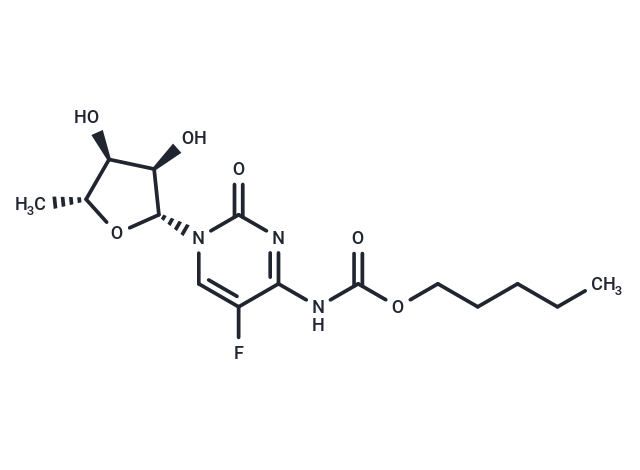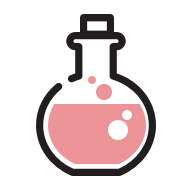- Remove All
 Your shopping cart is currently empty
Your shopping cart is currently empty
Shopping Cart
Capecitabine
Catalog No. T1408Cas No. 154361-50-9
Alias Xeloda, RO 09-1978, Capiibine, Capecitibine
Capecitabine (Capecitibine) is a fluoropyrimidine carbamate belonging to the class of antineoplastic agents called antimetabolites. As a prodrug, capecitabine is selectively activated by tumor cells to its cytotoxic moiety, 5-fluorouracil (5-FU); subsequently, 5-FU is metabolized to two active metabolites, 5-fluoro-2-deoxyuridine monophosphate (FdUMP) and 5-fluorouridine triphosphate (FUTP) by both tumor cells and normal cells. FdUMP inhibits DNA synthesis and cell division by reducing normal thymidine production, while FUTP inhibits RNA and protein synthesis by competing with uridine triphosphate for incorporation into the RNA strand.

Capecitabine
Catalog No. T1408Alias Xeloda, RO 09-1978, Capiibine, CapecitibineCas No. 154361-50-9
Capecitabine (Capecitibine) is a fluoropyrimidine carbamate belonging to the class of antineoplastic agents called antimetabolites. As a prodrug, capecitabine is selectively activated by tumor cells to its cytotoxic moiety, 5-fluorouracil (5-FU); subsequently, 5-FU is metabolized to two active metabolites, 5-fluoro-2-deoxyuridine monophosphate (FdUMP) and 5-fluorouridine triphosphate (FUTP) by both tumor cells and normal cells. FdUMP inhibits DNA synthesis and cell division by reducing normal thymidine production, while FUTP inhibits RNA and protein synthesis by competing with uridine triphosphate for incorporation into the RNA strand.
| Pack Size | Price | Availability | Quantity |
|---|---|---|---|
| 500 mg | $46 | In Stock | |
| 1 g | $62 | In Stock | |
| 5 g | $163 | In Stock | |
| 1 mL x 10 mM (in DMSO) | $48 | In Stock |
Bulk & Custom
Add to Cart
Questions
View MoreSelect Batch
Purity:100%
Contact us for more batch information
All TargetMol products are for research purposes only and cannot be used for human consumption. We do not provide products or services to individuals. Please comply with the intended use and do not use TargetMol products for any other purpose.Product Introduction
Bioactivity
Chemical Properties
| Description | Capecitabine (Capecitibine) is a fluoropyrimidine carbamate belonging to the class of antineoplastic agents called antimetabolites. As a prodrug, capecitabine is selectively activated by tumor cells to its cytotoxic moiety, 5-fluorouracil (5-FU); subsequently, 5-FU is metabolized to two active metabolites, 5-fluoro-2-deoxyuridine monophosphate (FdUMP) and 5-fluorouridine triphosphate (FUTP) by both tumor cells and normal cells. FdUMP inhibits DNA synthesis and cell division by reducing normal thymidine production, while FUTP inhibits RNA and protein synthesis by competing with uridine triphosphate for incorporation into the RNA strand. |
| In vitro | When administered to mice with a high propensity for liver metastasis, Capecitabine exhibits inhibitory effects on both the growth and metastatic recurrence of human hepatocellular carcinoma. This phenomenon is attributed to the high expression of platelet-driven endothelial growth factor within the tumors. Compared to 5-FU, UFT, and the intermediate metabolite 5'-DFUR, Capecitabine demonstrates a broader spectrum of anticancer activity against human transplant tumors, which is associated with the tumor levels of dThdPase. |
| In vivo | Capecitabine induces apoptosis in a Fas-dependent manner and exhibits toxicity sevenfold higher towards LS174T-c2 cells, which are transfected with thymidine phosphorylase, leading to more pronounced apoptosis. When cultured in the same plate as HepG2 cells, both LS174TWT and LS174T-c2 cells show increased sensitivity to Capecitabine, with IC50 values decreasing from 890 μM when LS174TWT cells are cultured alone to 630 μM when co-cultured with HepG2 cells. Additionally, for the LS174T-C2 subtype co-cultured with HepG2 cells, the IC50 significantly drops from 330±4 μM to 89±6 μM. |
| Cell Research | HepG2 and either LS174T WT or LS174T-c2 cells are seeded, respectively, in the top and bottom chambers of 8-well strip membranes in 96-well plates. The exponentially growing cells are exposed to increasing concentrations of capecitabine. The medium is supplemented with 750 ng/mL ZB4 MoAB or 100 ng/mL BR17 MoAB when the latter are used in the experiments. After 72 hours of continuous exposure, LS174T viability is assessed using the classic colorimetric MTT test.(Only for Reference) |
| Alias | Xeloda, RO 09-1978, Capiibine, Capecitibine |
| Molecular Weight | 359.35 |
| Formula | C15H22FN3O6 |
| Cas No. | 154361-50-9 |
| Smiles | O[C@H]1[C@@H](O[C@H](C)[C@H]1O)N2C(=O)N=C(NC(OCCCCC)=O)C(F)=C2 |
| Relative Density. | 1.49 g/cm3 (Predicted) |
Storage & Solubility Information
| Storage | Powder: -20°C for 3 years | In solvent: -80°C for 1 year | Shipping with blue ice. | ||||||||||||||||||||
| Solubility Information | 5% DMSO+95% Saline: 1.8 mg/mL (5.01 mM), In vivo: Please add co-solvents sequentially, clarifying the solution as much as possible before adding the next one. Dissolve by heating and/or sonication if necessary. Working solution is recommended to be prepared and used immediately. Ethanol: 35.9 mg/mL (99.9 mM), Sonication is recommended. DMSO: 35.9 mg/mL (99.9 mM), Sonication is recommended. | ||||||||||||||||||||
Solution Preparation Table | |||||||||||||||||||||
Ethanol/DMSO
| |||||||||||||||||||||
Calculator
In Vivo Formulation Calculator (Clear solution)
Please enter your animal experiment information in the following box and click Calculate to obtain the mother liquor preparation method and in vivo formula preparation method:
Mother liquor preparation method: 2 mg of drug dissolved in 50 μL DMSO (mother liquor concentration of 40 mg/mL), if you need to configure a concentration that exceeds the solubility of the product, please contact us first.
(mother liquor concentration of 40 mg/mL), if you need to configure a concentration that exceeds the solubility of the product, please contact us first.
Preparation method for in vivo formula: Take 50 μL DMSO main solution, add 300 μLPEG300
main solution, add 300 μLPEG300 mix well and clarify, then add 50 more μL Tween 80, mix well and clarify, then add 600 more μLddH2O
mix well and clarify, then add 50 more μL Tween 80, mix well and clarify, then add 600 more μLddH2O mix well and clarify
mix well and clarify
For Reference Only. Please develop an appropriate dissolution method based on your laboratory animals and route of administration.
Dose Conversion
You can also refer to dose conversion for different animals. More Dose Conversion
Tech Support
Please see Inhibitor Handling Instructions for more frequently ask questions. Topics include: how to prepare stock solutions, how to store products, and cautions on cell-based assays & animal experiments, etc
Keywords
Related Tags: buy Capecitabine | purchase Capecitabine | Capecitabine cost | order Capecitabine | Capecitabine chemical structure | Capecitabine in vivo | Capecitabine in vitro | Capecitabine formula | Capecitabine molecular weight

Copyright © 2015-2025 TargetMol Chemicals Inc. All Rights Reserved.



